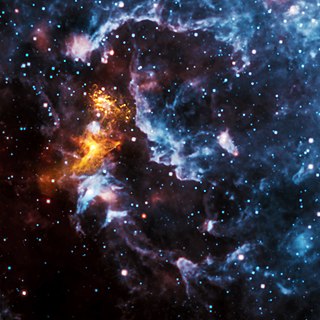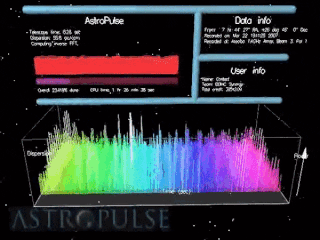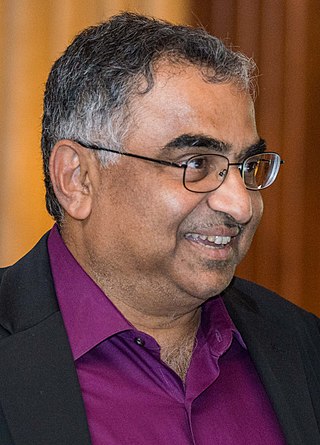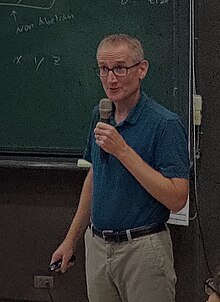
Russell Alan Hulse is an American physicist and winner of the Nobel Prize in Physics, shared with his thesis advisor Joseph Hooton Taylor Jr., "for the discovery of a new type of pulsar, a discovery that has opened up new possibilities for the study of gravitation".

Parkes Observatory is a radio astronomy observatory, located 20 kilometres (12 mi) north of the town of Parkes, New South Wales, Australia. It hosts Murriyang, the 64 m CSIRO Parkes Radio Telescope also known as "The Dish", along with two smaller radio telescopes. The 64 m dish was one of several radio antennae used to receive live television images of the Apollo 11 Moon landing. Its scientific contributions over the decades led the ABC to describe it as "the most successful scientific instrument ever built in Australia" after 50 years of operation.
An astronomical radio source is an object in outer space that emits strong radio waves. Radio emission comes from a wide variety of sources. Such objects are among the most extreme and energetic physical processes in the universe.

A pulsar is a highly magnetized rotating neutron star that emits beams of electromagnetic radiation out of its magnetic poles. This radiation can be observed only when a beam of emission is pointing toward Earth, and is responsible for the pulsed appearance of emission. Neutron stars are very dense and have short, regular rotational periods. This produces a very precise interval between pulses that ranges from milliseconds to seconds for an individual pulsar. Pulsars are one of the candidates for the source of ultra-high-energy cosmic rays.

Andrew Geoffrey Lyne is a British physicist. Lyne is Langworthy Professor of Physics in the School of Physics and Astronomy, University of Manchester, as well as an ex-director of the Jodrell Bank Observatory. Despite retiring in 2007 he remains an active researcher within the Jodrell Bank Pulsar Group. Lyne writes that he is "mostly interested in finding and understanding radio pulsars in all their various forms and with their various companions. Presently, I am most occupied with the development of new multibeam search systems at Jodrell and Parkes, in order to probe deeper into the Galaxy, particularly for millisecond pulsars, young pulsars and any that might be in binary systems."

Astropulse is a volunteer computing project to search for primordial black holes, pulsars, and extraterrestrial intelligence (ETI). Volunteer resources are harnessed through Berkeley Open Infrastructure for Network Computing (BOINC) platform. In 1999, the Space Sciences Laboratory launched SETI@home, which would rely on massively parallel computation on desktop computers scattered around the world. SETI@home utilizes recorded data from the Arecibo radio telescope and searches for narrow-bandwidth radio signals from space, signifying the presence of extraterrestrial technology. It was soon recognized that this same data might be scoured for other signals of value to the astronomy and physics community.
Dale A. Frail is a Canadian astronomer working at the National Radio Astronomy Observatory (NRAO) in Socorro, New Mexico.
Rotating radio transients (RRATs) are sources of short, moderately bright, radio pulses, which were first discovered in 2006. RRATs are thought to be pulsars, i.e. rotating magnetised neutron stars which emit more sporadically and/or with higher pulse-to-pulse variability than the bulk of the known pulsars. The working definition of what a RRAT is, is a pulsar which is more easily discoverable in a search for bright single pulses, as opposed to in Fourier domain searches so that 'RRAT' is little more than a label and does not represent a distinct class of objects from pulsars. As of March 2015 over 100 have been reported.

Shrinivas Ramchandra Kulkarni is a US-based astronomer born and raised in India. He is a professor of astronomy and planetary science at California Institute of Technology, and was director of Caltech Optical Observatory (COO) at California Institute of Technology, overseeing the Palomar and Keck among other telescopes. He is the recipient of a number of awards and honours.

Donald Charles Backer was an American astrophysicist who primarily worked in radio astronomy. Backer made important contributions to the understanding and study of pulsars, black holes, and the epoch of reionization.

Victoria Michelle Kaspi is a Canadian astrophysicist and a professor at McGill University. Her research primarily concerns neutron stars and pulsars.

PALFA is a large-scale survey for radio pulsars at 1.4 GHz using the Arecibo 305-meter telescope and the ALFA multibeam receivers. It is the largest and most sensitive survey of the Galactic plane to date.

In radio astronomy, a fast radio burst (FRB) is a transient radio pulse of length ranging from a fraction of a millisecond, for an ultra-fast radio burst, to 3 seconds, caused by some high-energy astrophysical process not yet understood. Astronomers estimate the average FRB releases as much energy in a millisecond as the Sun puts out in three days. While extremely energetic at their source, the strength of the signal reaching Earth has been described as 1,000 times less than from a mobile phone on the Moon.

Matthew Bailes is an astrophysicist and Professor at the Centre for Astrophysics and Supercomputing, Swinburne University of Technology and the Director of OzGrav, the ARC Centre of Excellence for Gravitational Wave Discovery. In 2015 he won an ARC Laureate Fellowship to work on Fast Radio Bursts. He is one of the most active researchers in pulsars and Fast Radio Bursts in the world. His research interests includes the birth, evolution of binary and millisecond pulsars, gravitational waves detection using an array of millisecond pulsars and radio astronomy data processing system design for Fast Radio Burst discovery. He is now leading his team to re-engineer the Molonglo Observatory Synthesis Telescope with a newly designed correlation system for observation of pulsars and Fast Radio Bursts (FRBs).

In radio astronomy, perytons are short man-made radio signals of a few milliseconds resembling fast radio bursts (FRB). A peryton differs from radio frequency interference by the fact that it is a pulse of several to tens of millisecond duration which sweeps down in frequency. They are further verified by the fact that they occur at the same time in many beams, indicating that they come from Earth, whereas FRBs occur in only one or two of the beams, indicating that they are of galactic origin. The first signal occurred in 2001 but was not discovered until 2007. First detected at the Parkes Observatory, data gathered by the telescope also suggested the source was local. The signals were found to be caused by premature opening of a microwave oven door nearby.
PSR J0540−6919 is a pulsar in the Tarantula Nebula of the Large Magellanic Cloud. It is the first extragalactic gamma-ray pulsar discovered.
Maura Ann McLaughlin is an astrophysics professor at West Virginia University in Morgantown, West Virginia known for her work on fast radio bursts (FRBs).

Ingrid Stairs is a Canadian astronomer currently based at the University of British Columbia. She studies pulsars and their companions as a way to study binary pulsar evolution, pulsar instrumentation and polarimetry, and Fast Radio Bursts (FRBs). She was awarded the 2017 Rutherford Memorial Medal for physics of the Royal Society of Canada, and was elected as a Fellow of the American Physical Society in 2018.
Manisha Pranati Caleb is an Indian and Australian astrophysicist whose research has used interferometry to detect fast radio bursts, studied the local context of fast radio bursts, used their signals as probes into the distribution of matter in the universe, and discovered repeating signals from what may be very slowly-rotating neutron stars. She is a lecturer at the University of Sydney, in the Sydney Institute for Astronomy.













